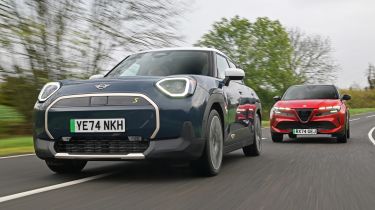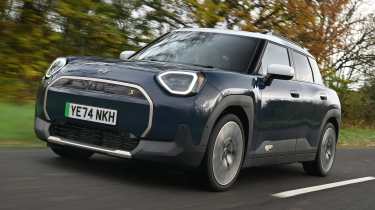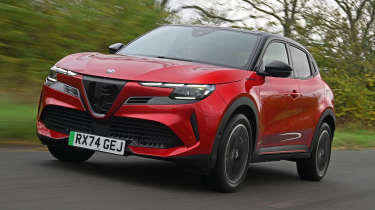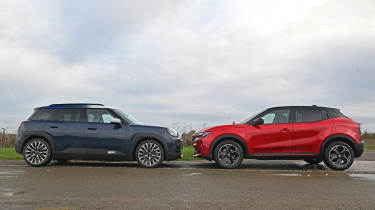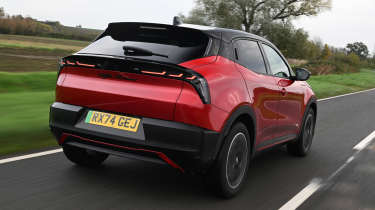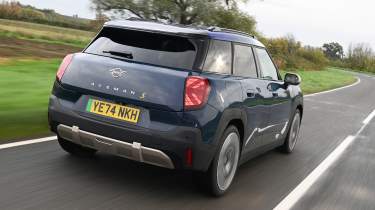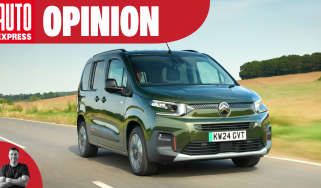MINI Aceman vs Alfa Romeo Junior: which little posh EV is best?
The MINI Aceman and Alfa Romeo Junior are aiming to make a splash in the compact electric SUV segment, but have they got what it takes?
Buying a big, posh SUV these days is child’s play. If you want something tall and battery-powered, most premium brands will have a model to tempt you.
But finding a compact electric car with a bit of prestige can be hard. There are a bunch of options from mainstream car makers these days – and thankfully they seem to keep getting cheaper – but mixing small and posh together tends to take a little more effort.
MINI was one of the first premium small-car brands to go electric, and the new Aceman is the third EV to join its range. It’s pitched as a compact crossover, sitting below the existing Countryman and above the Cooper Electric three-door hatchback, but does it share the same appeal as those models? Alfa Romeo hasn’t produced a small car since the demise of the MiTo in 2018 and the larger Giulietta two years later.
The brand’s first electric car sits between those two in terms of size. The all-new Junior has the style and the badge appeal to take on the MINI Aceman and give buyers in this segment an emotional reason to buy a compact electric crossover. We pitch Aceman and Junior head to head to find out which nails the brief best.
MINI Aceman
| Model: | MINI Aceman |
| Price: | £34,000 |
| Powertrain: | 1x e-motor, 54.2kWh battery, 215bhp |
| 0-62mph: | 7.1 seconds |
| Test efficiency: | 3.5 miles/kWh |
| Official range: | 244 miles |
| Annual VED: | £0 |
The Aceman is hard to pigeonhole within the MINI range, because at first glance it seems little different from the five-door hatchback in size, yet bears a different name and chunkier, SUV-inspired look.
Used - available now

2022 Volvo
XC40
50,185 milesAutomaticPetrol1.5L
Cash £19,100
2024 Volkswagen
Golf
67,155 milesAutomaticDiesel2.0L
Cash £15,200
2022 Peugeot
208
17,331 milesManualDiesel1.5L
Cash £12,700
2023 Tesla
Model Y Premium
48,817 milesAutomaticElectric
Cash £22,000The difference is in the powertrain; the Aceman is all electric, while the five-door hatch is petrol-only. What adds to the confusion is the fact that the three-door MINI is available with petrol and electric power, but despite looking nearly identical inside and out, the two models are based on completely different structures.
Tester's notes
There have been a number of cars in MINI’s recent past that, while looking undeniably unique, have felt a little fussy when it comes to detailing. The Aceman, and the smaller Cooper Electric, have introduced a new design direction, which aims to address this.
“Charismatic Simplicity” is intended to pare back unnecessary add-ons and focus on the features that make MINIs so distinctive. It’s clearly evident on the smaller hatchback, while the Aceman adopts a similar principle, but interpreted in a more squared-off SUV way.
Alfa Romeo Junior
| Model: | Alfa Romeo Junior |
| Price: | £33,895 |
| Powertrain: | 1x e-motor, 54kWh battery, 154bhp |
| 0-62mph: | 9.0 seconds |
| Test efficiency: | 3.6 miles/kWh |
| Official range: | 255 miles |
| Annual VED: | £0 |
Since falling under Stellantis ownership, Alfa Romeo seems to have been rather neglected beside some brands in the group’s vast empire, which means the Italian manufacturer has arrived rather late to the EV party.
With the new Junior, Alfa is determined to prove to its die-hard petrolhead fans that a stylish, compact EV can coexist alongside its superb performance offerings, such as the Giulia Quadrifoglio. If the Junior cuts the mustard, a small, premium EV parked alongside a V6-powered super-saloon sounds like an ideal two-car garage to us.
Tester's notes
There are small things that can make a car much easier to live with, and sometimes it feels like an Alfa Romeo wouldn’t be an Alfa without some slightly irritating omissions.
Take the charge port, for example. It’s placed on the rear wing like many petrol and diesel filler flaps, and most cars include a handy arrow on the instrument panel to tell you the side it’s on.
The Junior doesn’t, but for the sake of usability it seems to me like it couldn’t have been all that hard to just include one anyway.
Head-to-head
On the road
Based on pure numbers, these two are evenly matched. The MINI’s 54.2kWh battery is a negligible 0.2kWh larger, but the Alfa can charge at 100kW, which is 5kW up on its rival.
The big difference is the motor; the MINI’s 215bhp unit is comfortably up on the Junior’s 154bhp. That’s enough for a 1.9-second difference in 0-62mph times in the Aceman’s favour, which covers the sprint in an impressive 7.1 seconds.
Tech highlights
True to current MINI family form, the Aceman is incredibly sharp and darty to drive. However, this comes at the expense of a harsh ride quality, which even many hot hatch drivers will probably find a bit much.
In a list of great driver’s cars from Alfa, the Junior won’t trouble the top 10, but its balance between ride and handling is among the best in this class. Its steering feels more natural than the MINI’s, too.
Price and running costs
A £99 three-year service deal and the minimal costs to charge an EV make the Junior cheap to run. The MINI was a 0.1 miles/kWh less efficient than the Alfa on test and a little costlier to service, but it’s still cheaper to run than a similarly sized petrol car.
While some EVs have a reputation for hefty depreciation, that isn’t the case with either car here. The Aceman in particular has superb residual values.
Practicality
Neither car is the most spacious for the money, but the Alfa is the more practical car here. Rear headroom is impressive, but the Aceman trails its rival for kneeroom and shoulder space, and there’s a bigger disparity further back, where the MINI’s 300-litre boot is 100 litres short of the Junior’s. Both are compact on the road, with the Aceman barely four metres long and the Alfa less than 10cm longer.
Safety
Euro NCAP has yet to test either car, so while we can’t comment directly on their own performances, we can look at the Alfa’s mechanically similar Stellantis stablemates. The results have been a little underwhelming; the Jeep Avenger scored a three-star NCAP rating.
We have no data to go on with the Aceman just yet, but MINI generally performs well in NCAP tests.
Ownership
Alfa Romeo, and the Stellantis brands in general, have been showing a steady improvement in customer satisfaction ratings over the past few years. Alfa finished fifth in our Driver Power survey for brands in 2023, and 13th this year is still a strong result.
MINI buyers haven’t been so impressed with the brand in recent times, and while a 20th-place finish is not disastrous, it puts the firm in the bottom half of the table.
Verdict
Winner: Alfa Romeo Junior
There's a huge amount to like about the Alfa, with it beating many rivals when it comes to its ride/handling balance and unique personality. Its style, driving dynamics and decent residual values make this the most convincing Stellantis small EV money can currently buy, too, and it has the ability to see off its newest challenger, the MINI Aceman, in this contest.
But this win doesn’t make it a class-leader. Four stars is as good as it gets, because for similar money you can find rivals that offer more space and range plus faster charging.
Runner-up: MINI Aceman
If this test was based on interior style, quality and performance, then the MINI would trounce almost any rival we put it up against. Efficiency looks promising, too, and as always for a MINI, there’s plenty level of customisation on offer.
But for the money you’re not getting a huge amount of space, charging speed or range. Most disappointing is that the Aceman isn’t that impressive to drive. There’s no hiding its 1,800kg weight through the turns, and the ride is much too firm. For all the places the Aceman excels, it frustrates in others even more.
Prices and specs
| MINI Aceman | Alfa Romeo Junior | |
| Our choice | MINI Aceman SE Exclusive | Alfa Romeo Junior 156 Speciale |
| Price from/price of our choice | £34,000/£41,600 | £33,895/£35,695 |
| POWERTRAIN AND PERFORMANCE | ||
| Powertrain | 1x electric motor | 1x electric motor |
| Power | 215bhp | 154bhp |
| Torque | 330Nm | 260Nm |
| Transmission | Single-speed/fwd | Single-speed/fwd |
| 0-62mph/top speed | 7.1 secs/106mph | 9.0 secs/93mph |
| Battery capacity/usable | 54.2/49.2kWh | 54/51kWh |
| Official range | 244 miles | 255 miles |
| Test efficiency/range | 3.5mi/kWh/170 miles | 3.6mi/kWh/184 miles |
| Charging | 95kW (10-80% in 31 mins) | 100kW (20-80% in 27 mins) |
| DIMENSIONS | ||
| Length/wheelbase | 4,079/2,606mm | 4,173/2,562mm |
| Width/height | 1,514/1,754mm | 1,781/1,535mm |
| Rear kneeroom | 515-753mm | 528-768mm |
| Rear headroom/elbow room | 955/1,398mm | 900/1,465mm |
| Boot space (seats up/down) | 300/1,005 litres | 400/1,265 litres |
| Boot length/width | 600/949mm | 718/976mm |
| Boot lip height | 765mm | 748mm |
| Kerb weight/towing weight | 1,785/750kg | 1,545kg/N/A |
| Turning circle | 11.1 metres | 10.8 metres |
| COSTS/OWNERSHIP | ||
| Residual value (after 3yrs/36,000 miles) | £23,259/55.91% | £18,676/52.32% |
| Depreciation | £10,741 | £15,219 |
| Insurance group/quote/VED | 24/£627/£0 | 23/£589/£0 |
| Three-year service cost | £512 (four years) | £99 |
| Annual tax liability std/higher rate | £159/£318 | £143/£285 |
| Annual fuel cost (10k miles) | £700 | £681 |
| Basic warranty/recovery | 3yrs (unlimited)/3yrs | 3yrs (unlimited)/1yr |
| Driver Power manufacturer position | 20th | 13th |
| NCAP Adult/child/ped./assist/star | N/A | N/A |
| EQUIPMENT | ||
| Metallic paint/wheel size | £550/18 inches | £700/18 inches |
| Parking sensors/camera | Rear/360-degree | F&r/360-degree |
| Spare wheel/Isofix points | Repair kit/three | Repair kit/two |
| Keyless entry & go/powered tailgate | £2,000 (part of pack)/No | Yes/yes |
| Leather/heated seats | Yes/£2,000 (part of pack) | No/yes |
| Screen size/digital dashboard | 9.4 inches/yes | 10.25 inches/yes |
| Climate control/panoramic sunroof | Yes/£2,000 (part of pack) | Yes/£1,200 |
| USBs/wireless charging | Four/£2,000 (part of pack) | Three/£1,350 (part of pack) |
| Wireless CarPlay/Android Auto | Yes/yes | Yes/yes |
| Blind-spot warning/head-up display | Yes/£2,000 (part of pack) | No/no |
| Adaptive cruise/steering assist | Yes/yes | Yes/yes |

